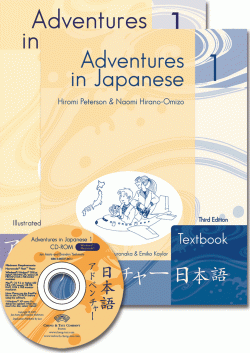This user-friendly and comprehensive series combines cultural activities with beginning-to-advanced language learning instruction that emphasizes proficiency in speaking, listening, reading and writing.
Widely adopted across the nation, Adventures in Japanese is used in school systems from New York City to Honolulu, from Boston to Anchorage. Volume 1 gently but thoroughly introduces hiragana and katakana in order to acclimate students to the Japanese writing system. By the end of Volume 4, students will have learned 340 kanji. Culturally related activities and topics—from making onigiri (riceballs) to learning Japanese songs to understanding Japan’s educational system—enrich students’ learning while preparing them for the AP* Japanese exam. The flexibility of this series allows for endless activities and projects to be built around the lessons, and aids teachers in integrating the National Standards for Foreign Language Education’s “5Cs”: Communication, Cultures, Connections, Comparisons, and Communities.
The Adventures in Japanese series stresses cultural comparison. Students are constantly exposed to Japanese customs and encouraged to compare Japanese culture with their own. A “Japanese Culture Corner” presents culture through a series of projects and activities that students can research and share with classmates. The “Fun Corner” adds to this element of cultural education with Japanese crafts and games like origami, making mochi, and karuta.
Volume 1
In Volume 1, students learn to talk about themselves (family, daily routines, school, inviting a friend over, etc.). The vocabulary allows beginners to immediately engage in basic conversation. Hiragana and katakana are introduced gradually, so students feel comfortable with the characters. Seventeen basic kanji are also introduced.
Volume 2
In Volume 2, students expand their horizons by learning to express themselves in a Japanese-speaking community. Romanization is no longer used, and at the completion of this level, students will have learned a total of 113 kanji. A useful list of previously introduced vocabulary and grammatical structures is included at the end of each lesson.
Volume 3
In Volume 3, students learn about Japan through the eyes of Ken, who spends a year studying in Japan and living with a host family. By the end of Volume 3, students will have learned a total of 219 kanji.
Volume 4
In Volume 4, the focus is on “the Japanese soul”: the social and cultural forces that influence the ways of the Japanese. Students examine such wide-ranging topics as keigo (honorifics), the World War II experience (for Japanese in Japan and Japanese-Americans in the U.S.), and the cultural art of the tea ceremony.
Series Dictionary
The Adventures in Japanese Dictionary contains Japanese-English and English-Japanese listings, a kanji list, a verb list by conjugation group, adjective lists, and adverb lists. Available independently for users of the second edition of Adventures in Japanese, it covers Volumes 1 through Volume 4 in the series (third edition textbooks include a cumulative glossary in the textbook itself or a separate dictionary packaged in).
For online study resources, discussion forums, and more, check out the Companion Website for Adventures in Japanese!
*AP is a registered trademark of the College Board, which was not involved in the production of, and does not endorse, this product.
In this Series
Volume 4
Volume 3
Volume 2
Volume 1
Images CD-ROM
Dictionary
The grammar explanations are so user-friendly. Unlike usual "grammar-speak," these explanations make sense to my students. They are concise and easily understood.
I have never used anything else, but I used "Adventures in Japanese" when I taught Japanese for an online high school. My students enjoyed the book and thought the drawings were cute. I also like the book because it is NOT in color. Textbooks these days tend to be on color overload. The students' eyes have enough to worry about learning to read in a new writing system without being distracted by unnecessary color.
I think Adventures in Japanese is very good for my audience of students (high school, intensive). I think the pace is very good, and it is easy for me to adapt by adding other activities, TPR, more kanji, etc. I find the students find their AIJ textbook to be very approachable.
I use AIJ. They have supplementary workbooks, which I think are essential for writing practice. I like the order they teach things in and you can add kanji as you want...It's a good pace for high school and even junior high.




















